
|   |

|   |
Silver Jubilee edition of Pt. Durgalal Festival - Shyamhari Chakra e-mail: shyamhari@yahoo.com March 10, 2015 As dusk descended on India’s west coast and the moon ascended over Mumbai’s skyline, the aesthetically decorated amphitheatre at the Bhavan’s Cultural Centre in Andheri beside the lotus-laden Pran Ganga lake witnessed an august assembly of artistes and arts connoisseurs for a special occasion - inauguration of the silver jubilee edition of Pandit Durgalal Festival (Jan 30 &31, Feb 1) hosted by the city’s best known Kathak exponent Uma Dogra in honour of her guru and mentor, late legendary Durga Lal, who passed away a quarter century ago at the young age of 42. After anchors Namrata and Indrayanee - both gifted young dancers - made their opening announcements about the unique occasion that coincided with 50 years of journey of Uma Dogra as a dancer, in a voice that was replete with ethos and pathos, a minute’s prayer of silence was observed for the departed souls of Kathak legends Sitara Devi and Chitresh Das who passed away recently. And then, as the evocative Sanskrit sloka of Gurur Brahma Gurur Vishnu, Gurur devo Maheshwara was being recited, actress and dancer Hema Malini - a close friend of Uma Dogra - lighted the ceremonial lamp marking the inauguration. Then, for offering of floral tribute at the life-sized portrait of Pandit Durga Lal, she was joined by dancers Kanak Rele and Darshana Jhaveri, tabla maestro Pandit Nayan Ghosh and Bala Durgalal, wife of late Durga Lal, who was specially flown in from Delhi for the occasion. Adding distinction to the occasion, several stalwarts from the field of Indian classical dance were among the gathering 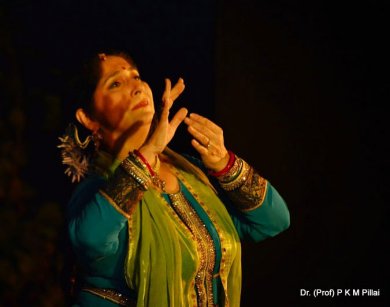 Uma Dogra 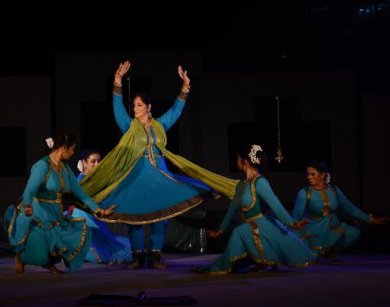 Uma Dogra and group Uma Dogra was visibly and intensely emotional as she poured out her heart for her beloved guru during her concert. In fact, her invocatory presentation was aptly chosen for the Guru - Brahmanandam, Bhabatittam, Trigunarahitam; Sadgurum twam namami. It was followed by her second solo set to Adi Sankaracharya’s Shiva Panchakshara Stotram - Nagendra Haraya Trilochanaya. Moving on, Uma Dogra presented a pure dance number - taal Dhamar - joined by two of her disciples. And then she enacted poet Jayadev’s popular astapadi Dheera Samire, Yamunatire and concluded her concert with a group composition Pancham Sawari accompanied by four of her disciples. She defied age as she was seen dancing with unbound joy and energy like a teenager along with her young band of energetic accompanying dancers. The live orchestra that accompanied the concert contributed a lot in elevating the appeal of the show. Vocalist Manoj Desai and flautist Vijay Tambe deserve a special mention. Erasing borders between Hinduism-Islam, folk-classical and India-Pakistan, mesmerizing Manganiyar musician Mame Khan, who hails from a family of 15 generations of master musicians from a village near Indo-Pak border in Rajasthan had the audience glued to their seats for nearly two hours with his captivating concert despite commencing late during the evening. Even when he concluded, the audience was not in a mood to let him stop! The lone music concert in the three-day dance festival, it was the greatest attraction for them. The audience literally danced to the tune of the musicians who made them intimately involved with the music. The concert led by the stylized singer who is gifted with an incredibly high range of voice that suits folk, classical and Sufi genres of music with equal ease, comprised a harmonious combination of solo and choral singing. It has enough scope for the instrumentalists to showcase their talent and expertise - a rare gesture that the vocalists demonstrate during music concerts. 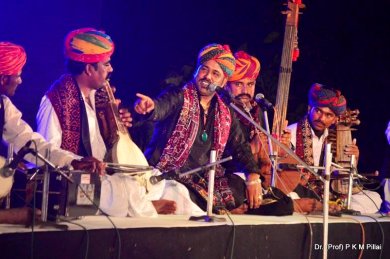 Manganiyar musicians 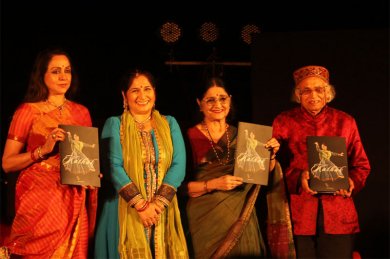 Book release The evening also witnessed release of the book In Praise of Kathak by Hema Malini penned by Uma Dogra and published by her Samved Society for Performing Arts. Veteran dance historian and critic Dr. Sunil Kothari and eminent Mohiniattam exponent Dr.Kanak Rele were on the dais among others on the occasion. The elegantly produced book with a number of rare photographs contains the writer’s and her late guru’s brief biographical sketches besides chapters on the four gharanas of Kathak and notes on the theory and techniques of Kathak. The mood of the second evening was perfectly set by Mohiniattam dancer Gopika Varma. It was spring. The genteel breeze was blowing amidst the brightly lit lush green trees encircling the amphitheatre. As the dancer, holding a lamp in her palms, entered the stage to the soulful rendition of the sloka Santakaram Bhujangasayanam, Padmanabham Suresham invocating Lord Vishnu, there was divinity in the air. Dedicating her concert to her manasiga guru (whom one accepts as guru in thought) eminent Mohiniattam exponent Kanak Rele who was present in the audience, Gopika Varma staged three of her compositions. The first one, delineating the attributes of Keshava and Shiva, was woven around a series of stances, movements and enactments establishing nice juxtapositions of lasya and tandava. The next number, a Swathi Thirunal bhajan in Hindi that she mentioned was “for the rasikas of Mumbai” - Yamuna kinare, Bansuri bajawe - was the story of a Gopika who is in love with Krishna and who sends a cow as her messenger to him with several references about the beloved’s persona. The concluding piece, also on Krishna, was based on a popular folklore of Kerala, the land of Mohiniattam that revolved round the amorous arguments of Krishna with wife Rukmini during their game of dice. The hallmark of Gopika Varma’s performance was her spontaneity and subtlety in emoting - never did she appear like enacting or imitating any action or emotion. She lived the moments and emotions in her marvelously mature performance. 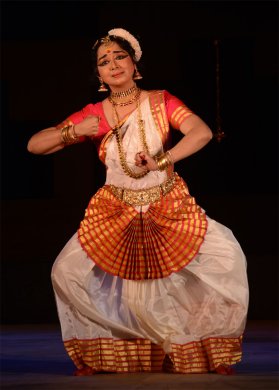 Gopika Varma 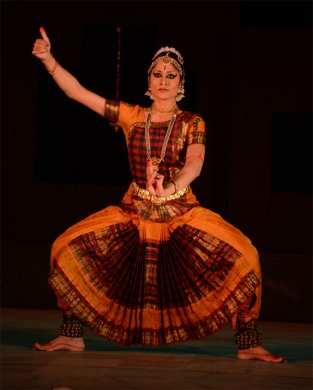 Janaki Rangarajan US-based young and accomplished Bharatanatyam artiste Janaki Rangarajan, the youngest dancer of the festival, lived up to her reputation of having an excellent grip over pure dance presentations. It is her amazing body kinetic that makes her dance distinctly different from the rest in her league. It appeared as if the body faithfully carried any command that the dancer demanded. Her nice exploration of the body kinetic apart, she was at her best in judicious exploration of the stage space during the concert. Her presentation comprised of an invocation to Lord Muruga followed by the principal presentation of her repertoire - swarajati - that delineated the nayika’s love for the Lord at the Brihadeshwara temple in Tanjore; enactment of poet Jayadev’s poignant astapadi Yahi Madhava, Yahi Keshava and the concluding tillana. The third and concluding evening of the festival belonged to Swapnasundari - the name that commands utmost respect for her depth in dance and scholarship. The dancer took her audience of a large number of dancers and connoisseurs on a pleasant trip to revisit the lost tradition of the dance of the devadasis of Andhra Pradesh (that included the recently created Telengana) that she has named as Vilasini Natyam. Recreating an ambience of the Bisweshwar temple in the east Godavari district in the Telugu land - through a lucid commentary - where the temple dancers of yesteryears used to perform for the Lord, she commenced her captivating and enlightening concert with the customary Vinayaka prarthana, a composition of her guru who used to dance the number at the temple premises. The three interesting slokas described the saptaswaras - the seven musical notes - followed by the taal and the laya. Following the invocatory number, Swapnasundari presented excerpts from the immensely popular composition Navajanardana Parijatam that would be staged by nine devadasis spread over nine nights! She spoke, she sang, she danced and she enacted, all with élan and effortless ease, despite performing extempore. As soon as the dancer-commentator introduced Satyabhama, the protagonist, in the traditional introductory segment of patra pravesham, the audience witnessed an amazing transformation of Swapnasundari into Satyabhama, the lady with incredible beauty, brain and wit who, drawing metaphors from nature described her body and beauty as well as the persona of her beloved husband Krishna whom she never names. The dancer’s eloquent eyes convincingly conveyed the nuances of the characters, the bhavas and the rasas. 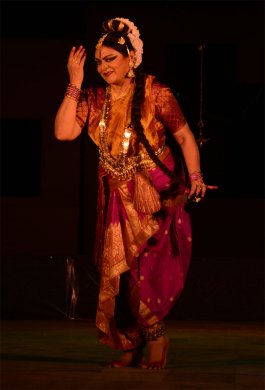 Swapnasundari 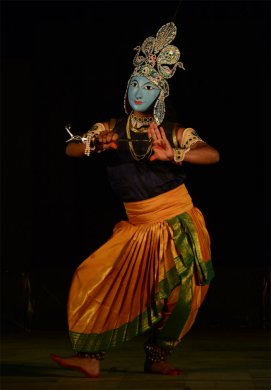 Seraikella Chhau The festival concluded with the masked martial dance of Seraikella Chhau presented by New Delhi based exponent Sashadhar Acharya. “I wish to show that Chhau is not all about martial matters such as war or hunting,” stated the exponent who performed along with his brothers and son in the troupe and presented four impressive compositions - Ratri (night), Hamsa (swan), Mayura (peacock) and Radha-Krishna. Despite absence of any lyric to tell the tale, Ratri convincingly conveyed the story. As the character clad in black costume, entered the stage holding a lamp, it suggested the beginning of the night with sandhya (evening). Sandhya grows into Ratri and then appears the moon clad in white costume. And the love play between the night and the moon begins. The pace of the music and the drum-beats wonderfully denoted the moods of the actions in progression. One wondered how the magically crafted masks appear like human faces emoting the moods of the characters with equal eloquence! Sekhar Sen, the newly appointed Chairperson of Sangeet Natak Akademi, New Delhi, was the special guest for the concluding evening of the festival. The event was supported by the Ministry of Culture, Government of India, and sponsored by ITM Group of Institutions of Mumbai. A former journalist and arts critic with The Indian Express and The Hindu newspapers for nearly 20 years in Bhubaneswar, Shyamhari Chakra is currently based in New Delhi as a writer on dance matters. He writes for The Hindu, www.narthaki.com, Sruti and Nartanam. |